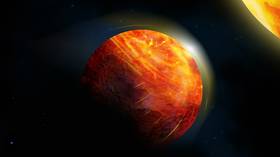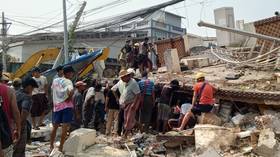Hellish planet has lava oceans, supersonic winds and scorching vaporized rock downpours

Imagine a world so hostile to life that it has bubbling lava oceans and it rains vaporized rock. That’s exactly what researchers discovered in a distant galaxy and it could shed light on the formation of our own planet.
A team of researchers investigating the hellish exoplanet K2-141b say it is one of the most “extreme” worlds ever discovered. A fresh study of the planet found that its surface, oceans and atmosphere are all made of rocks in various different forms. It boasts 100km deep magma oceans, rock glaciers and even a vaporized rock atmosphere.
Just to top it all off, the bizarre world is also battered by winds with speeds of over 1.75 kilometers per second, faster than the speed of sound on Earth.
The planet is around 1.5 times the size of Earth and it is so close to its star that it is able to complete full orbits several times per day.
Also on rt.com Astronomers catalogue 1,000 worlds that can ‘see’ Earth – and are candidates for possible COLONIZATIONThe same surface also permanently faces the star, meaning that two-thirds of the planet is permanently sunlit and experiences temperatures of over 5,400 degrees Fahrenheit. This scorching temperature is enough to vaporize rocks, giving this part of the planet a thin inhospitable atmosphere.
“Our finding likely means that the atmosphere extends a little beyond the shore of the magma ocean, making it easier to spot with space telescopes,” explained the study’s co-author Nicolas Cowan.
The rest of the planet is cloaked in permanent darkness and temperatures plummet to 328 degrees Fahrenheit.
The researchers created models of what the conditions would be like on the hellish surface based on three potential main ingredients, all of which are common in the crusts of rocky planets.
“All rocky planets, including Earth, started off as molten worlds but then rapidly cooled and solidified. Lava planets give us a rare glimpse at this stage of planetary evolution,” Cowan said.
The research team is hoping to further verify the observations gleaned from their models after the James Webb Space Telescope launches in 2021.
Also on rt.com One of the most extreme planets ever discovered spotted by astronomers equipped with long-range probeLike this story? Share it with a friend!















